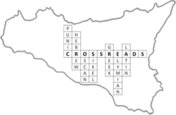Epigraphy meets petrography: preliminary observations of the materials used to make funerary inscriptions in the catacombs of Siracuse.
I have recently been asked how often I use my taste buds to identify marble. I had to admit that although some stones can be distinguished by taste (i.e., licking), this is not the type of test I would normally resort to.
Within the ERC-funded Crossreads project I am dealing with the identification of the supports on which inscriptions are found across ancient Sicily, the vast majority of which are hewn from stone. The I.Sicily database comprises approximately 4,500 inscriptions, and the corpus is growing.
The survival of many of these documents is largely due to their resistance to natural processes of decay, and to human intervention. In addition, the choice of support and the techniques used to produce an inscription can provide us with information about the social and cultural environment. Inscriptions have a dual nature: they are a text (which can be read, drawn, transcribed, and reproduced in squeezes or photographs that can, in turn, be digitized, interpreted, and edited) and they are a material entity, made of substances carefully handled to produce an object in response to a specific need. Materials and techniques can also yield information about the wealth and power of the commissioner, the technical skills and craftsmanship of the artisan, trade routes, and the exploitation of local natural resources.
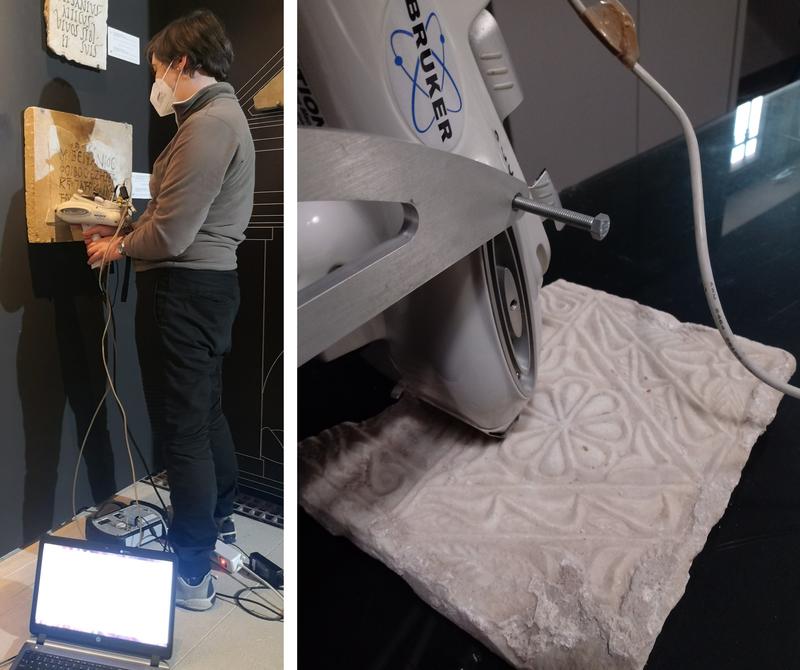
Fig. 1 Portable X-ray fluorescence analysis conducted at the Museo Civico Castello; Pontificia Commissione di Archeologia Sacra in Syracuse. Reproduction courtesy of the Pontifical Commission of Archaeological Sacra.
The correct identification of a material requires the use of clear, univocal terminology, as well as an awareness of the historical usage of materials and techniques. These two aspects need to be carefully considered to avoid misattribution. Drawing upon literary sources on the exploitation of materials (such as Pliny the Elder on stones, pigments and metals, for example, or the historical literature describing the conquest of mines and quarries) poses some problems, since the actual correspondence between Latin terminology and a specific mineral or rock is often open to question, especially since many well-known mines and quarries of antiquity were subsequently exhausted, meaning that the identification of places described in the literature is often far from being clear cut.
The univocal description of materials, and the precise correspondence between a name and a specific assemblage of atoms or molecules started in the 19th century, when the development of chemistry and crystallography allowed scientists to unravel the physical and chemical properties of solid matter. As a result, the name given to each mineral has come to describe a specific chemical formula, indicating which elements are present, and in what proportion, and also the specific arrangement of atoms in terms of the distance and angles between them. The symmetry ruling the arrangement of atoms and ions at the atomic scale is maintained up to the macroscopic scale and can be observed in minerals which have been allowed to grow without interference (think of crystals inside a geode). More often minerals are found in complex and apparently chaotic assemblages, such as rocks. Here again, the types of minerals present, and their relative proportion, enable one to describe rocks with some precision. It is also important to consider their geological origin (whether igneous, sedimentary, or metamorphic) as well as information on the size, shape, arrangement of crystals or grains, on their homogeneity and isotropy (fabric and texture). The names given to rocks are designed to include all this information, following established conventions.
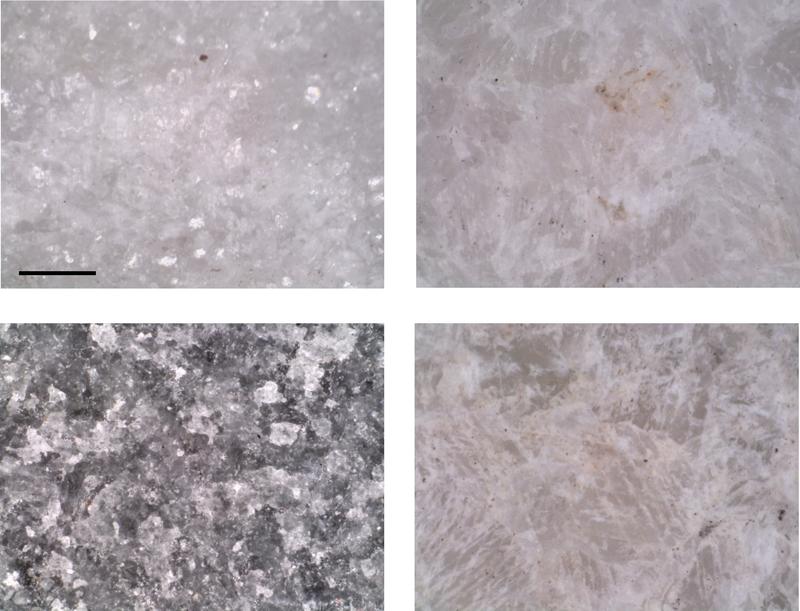
Fig. 2 Microphotographs acquired in situ of inv000033, inv000131 and inv015513. Reproduction courtesy of the Parco archeologico e paesaggistico di Siracusa, Eloro, Villa del Tellero e Akrai.
Today, the use of these analytical techniques developed in the field of natural sciences to study objects from our past is called archaeometry, lit. 'the measurement of ancient objects', or archaeological science. What are the specific research questions that archaeometry can help us to solve? They encompass the creation of the object and the selection of materials (local/imported; cheap/expensive), chronological observations (the presence of materials that can be dated, such as wood, or materials for which use/discontinuation dates are known), the assessment of authenticity (which is most often addressed, from a material science point of view, as a matter of coherence between the materials and the proposed timeframe). In addition, archaeometry can inform us about the history of an object, how it has aged, and on human interventions (including restoration treatments) which may have altered its original appearance. The detection of materials prone to decay under certain conditions, and of ongoing alteration processes is, finally, of fundamental importance for conservation, which in turn informs restoration, and the ethics of preserving and valuing the testimonial evidence from the past.

Fig. 3 X-ray fluorescence spectra of white crystalline marble.
Although archaeometry can help to answer questions of provenance and the manufacture of material records of archaeological interest, it seems that epigraphers have shown little interest in this field. Yet the assessment of patterns of using certain types of stone for specific documents, within social groups in a specific timeframe, or the link between palaeography and a certain type of stone, should be of interest to epigraphists and historians, as it is to archaeologists.
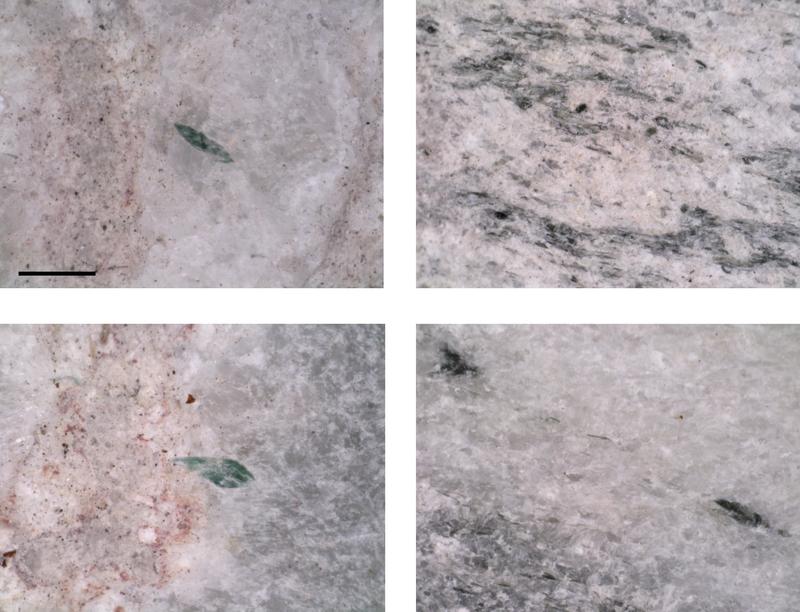
Fig. 4 Microphotographs taken in situ of inv01568 and inv01556. Reproduction courtesy of the Parco archaeologic e paesaggistico di Siracusa, Eloro, Villa del Tellero e Akrai and Pontificia Commissione di Archeologia Sacra-- Ispettorato per le Catacombe.
It is for this reason that a whole work strand of research in Crossreads is dedicated to petrography. Here, the aim is to test approximately half the inscribed stones on the island. From the geological point of view, Sicily offers a wide variety of building and decorative stones. Traditionally, for masonry, the lithotypes in use have tended to correspond to the locally outcropping geological formations, whose exploitation continues to this day (e.g. lava stone around Mt Etna, the golden-coloured fossil-bearing stone of Agrigento, limestones and sandstones in the Hyblean area, etc). Moreover, a variety of multi-coloured decorative stones, whether sedimentary or low-grade metamorphic in origin, rivalling the typical Roman period veneers and slabs, are to be found on the island, although their use is only recorded to have begun in the Baroque period, with a few exceptions. No white marble formation is present on the island. From the historical point of view, it appears evident that Greek colonisation brought marble and other exotic stones to the island, substituting (especially for institutional purposes and in monumental sites) the local stones used by the indigenous populations. A wider variety of decorative stones, marmora, appeared on the island following the Roman conquest of the Mediterranean and the taste for decorative stones from Tunisia, Egypt, mainland Greece and the islands, Turkey, and later Luni-Carrara marble from the Apuan Alps dates from this period.
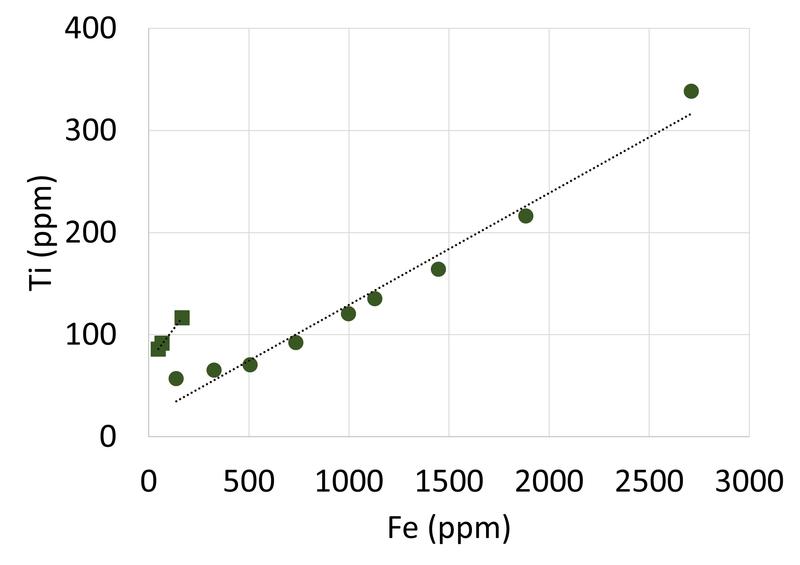
Fig. 5 The Titanium and iron contents of two cipollino slaps Inv015568 and Inv015566.
Within the context of the Christian catacombs in Syracuse we can observe a specific set of materials. Besides the use of local stones (whitish limestones of varied compactness), we find imported crystalline marbles and decorative stones in widespread use. It appears that funerary slabs were often made by repurposing stones from architectural and decorative features, such as veneers, architraves, pilasters, etc. These spolia (lit.'spoils') are used creatively and ingeniously in the underground galleries, creating a vibrant, multi-coloured scene, where red rubrication, although now almost completely lost, must have been widespread.
The initial phase of petrographic research conducted on funerary inscriptions in the catacombs concerned a set of ca. 150 stones. This was conducted in a fully non-invasive way, by autoptic observation, digital microscopy to capture details of both the stones and the rubrication, and by non-destructive chemical analysis using a portable X-ray fluorescence (XRF) spectrometer within the premises of the Museo Archeologico Regionale “Paolo Orsi” and at the antiquarium of the Pontificia Commissione di Archeologia Sacra, both in Syracuse.
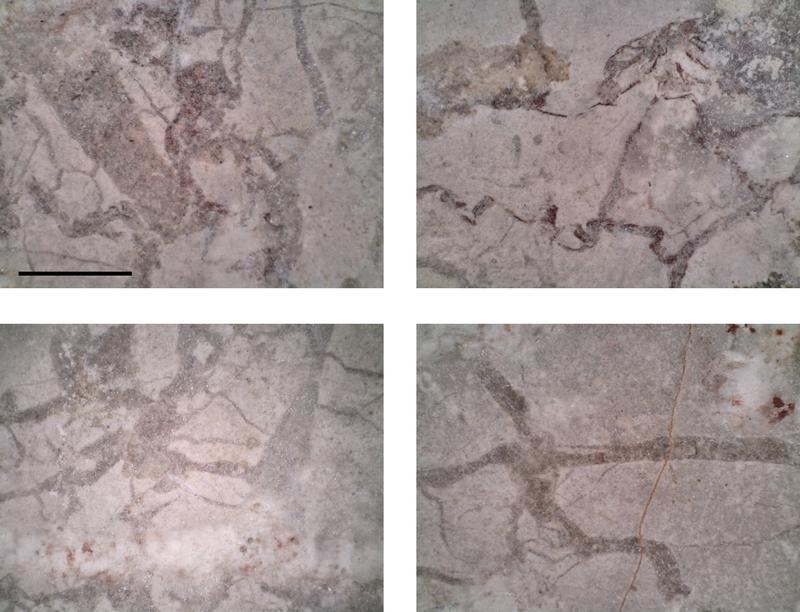
Fig 6. Bracciated limestone
Autoptic observation of the stones allowed us to assess the wide distribution of crystalline white to grey marbles, with different grain sizes, which account for more than 80% of the stones. Some examples of scritto marble have been observed, as well as cipollino and pavonazetto. In this group of imported stones, representing 92% of the set, re-use of earlier decorative features is clear (e.g. inv000033), as well as short-term repurposing of funerary slabs ( e.g. inv014446).
A slightly different non-invasive approach has been deployed for genuine marble and for the other stones, in order to focus on the most promising features for their correct identification. For marble, these consist of the grain size, accessory minerals and trace elements, while for other stones it is the macro- and microscopic appearance and the general chemical composition, including traces which is key.
Typically, grain size measurement for crystalline marbles is done on a thin section (30µm, thinner than a sheet of printer paper) prepared from a sample of approximately 1cubic centimetre (roughly the size of a hazelnut). At this thickness even rocks become transparent to light: the single rock-forming mineral crystals can be identified by their optical properties using a petrographic microscope, and their size and shape can be measured and described. On this occasion, in order to avoid sampling, a digital microscope was used to acquire high resolution, high magnification images of crystalline marble, and the maximum grain size MGS was obtained from such pictures. As MGS values have been tabulated for decades for different marble, highlighting the variability of each and overlapping values across different ones, it is possible to refer to those data for comparison. The re-used decorative element inv000033 appears to have a fine grain size, smaller than 0.2mm, and matches both Luni-Carrara and Afyon marbles. Another fine-grained marble, of a dark grey colour (inv000131), shows a slightly larger size up to 0.5mm; in addition to Luni-Carrara and Afyon, this stone matches the finest varieties from Aydin and Penteli. On the other hand, inv015513 is a sugary marble with MGS of ca. 1.5mm, this is a typical value for the crystalline marbles of present-day Turkey (Afyon, Aydin) and Greek islands (Paros, Thasos). Moreover, the larger calcite crystals of inv015513 show sets of parallel lines with an angle of 120°: these are called twinning lamellae and are formed during the recrystallization of minerals during metamorphism, their thickness and spacing being correlated to pressure and temperature conditions in which the marble was formed. Inv015502 displays a so-called lepidoblastic fabric, indicating the presence of aligned crystals, typically phyllosilicates, in this case of silvery appearance. These accessory minerals are worth further investigation as potential provenance markers.
The X-ray fluorescence spectra acquired from analysing crystalline marbles are monotonously repetitive, as they are invariably characterized by the intense emission lines of calcium, and little else. However, the additional signals due to trace elements such as iron, vanadium, titanium, rubidium, strontium, zirconium etc., and their relative proportions need to be thoroughly investigated to support the identification of chemically homogeneous groups. As XRF analyses are fast (60 seconds each) and completely non-invasive, Crossreads aims to use this technique to test approximately half the inscriptions of Sicily. Moreover, multiple spectra are acquired from each stone, to take into account the natural variability of the rock itself. The obtained spectra are then processed, using dedicated software for extracting both qualitative and quantitative information, and for statistical data analysis. It is interesting to note that preliminary chemical data suggests a strong resemblance between the fine grained repurposed marble of inv000033 and the coarser one used in inv015513. The observed granulometry values are compatible both with Carrara and Afyon. In cases like this, further analysis on a small sample will allow one to investigate its isotopic composition in detail, as well as distinctive minero-petrographic features to discriminate between the two proposed locations.
Another interesting case concerns two cipollino pieces. The first inscription, which comprises inv015561 and inv015566, shows the typical banded and folded structure of this well appreciated decorative stone, with a lepidoblastic fabric showing dark green areas of iron-containing silicates (chlorite, epidote, serpentine). The appearance of the stone varies significantly between the edges of the slab, often broken along these dark green layers, and its surface characterized by lens-shaped green specks, as the piece was cut almost perpendicular to the layers. The accessory minerals in this inscription appear much darker than those observed in inv015568d. Also, chemically there is a difference between the two stones, with the lighter inv015568d being depleted in zirconium (Zr) and enriched in potassium (K) in respect to inv015561 and inv015566. Although Euboea was the most common source of this rock, providing both lighter varieties and more colourful ones (see Corsi 89 and 90 in the Corsi Collection of Decorative Stones in Oxford University Museum of Natural History), similar lithotypes have been reported in Italy (in the Apuan Alps, Corsi 92) and elsewhere.
In addition to fancy imported stones, most probably repurposed from earlier buildings, local stones are also to be found in this Christian funerary context. Inv000068 is a compact cream-coloured brecciated limestone. This type of limestone with whitish and dark red veins occurs in the North-Western part of Sicily, close to Alcamo, some 300 kilometres from Siracuse, but similar lithotypes are also attested in the central Apennines (so-called Cottanello), and in North-Eastern Italy close to Verona (see for example Corsi187 and Corsi 44 or 521, respectively). In this case, it would be interesting to assess whether the Sicilian quarries, heavily exploited since the 18th c. and nowadays almost exhausted, were already known in antiquity, or if this stone was imported from afar.
Finally, an inscription on slate has been detected (inv014610). Slate is formed when low temperatures and pressures are applied to non-carbonatic sediments of fine grain size, and is characterized by thin layers, or foliation. The typical Italian location for such rock is Lavagna, in the Northern Apennines, and others are found in Spain, France and Germany, while no commercially exploitable outcrops are known on the island. In this case, a detailed study of the geological maps of Sicily will support the identification of possible local slates for comparative analysis, and to assess trade routes.
As these examples indicate, it appears that a tailored testing approach can provide additional information on the social practices of a developing community, such as the Christian one in Syracuse. Of course, the preliminary results obtained by in situ observations, both by the naked eye and through a microscope and the chemical analyses are not conclusive, yet they are vital to design an optimized analytical strategy for the characterization of the materials. In fact, the long-term objective of this non-invasive project is to facilitate the definition of groups of similar rocks, from which only few representative samples will need to be taken to the laboratory.
During the course of processing the data acquired in situ, the peculiarity and diversity of the materials used in the catacombs of Syracuse has become ever more apparent. Of course, the re-use and repurposing of earlier architectural and decorative elements does complicate any general assessment of the trade in marble and decorative stones and its chronology. Nevertheless, the wide prevalence of white crystalline marbles is striking, and the variety of granulometry and colour suggests a range of diverse sources of these stones which will merit further research. Indeed, the panorama of decorative stones traded across the Mediterranean is becoming ever more complex as smaller local outcrops appear to have been exploited in substitution for exotic stones. Assessing and quantifying the occurrence of different stones is the first task of petrographic analysis, the next task will be to assess these results so as to achieve an understanding of the social and cultural dynamics at the crossroads of the ancient Mediterranean.
The blog of the Crossreads project, based at the CSAD in the Faculty of Classics, University of Oxford, between 2020-2025. We will be adding regular updates on our research and news of our project publications.
Crossreads: text, materiality and multiculturalism at the crossroads of the ancient Mediterranean has received funding from the European Research Council (ERC) under the European Union's Horizon 2020 research and innovation programme (Grant agreement No. 885040).

